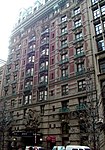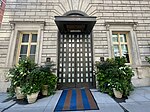Holland House (New York City)

Holland House was a New York City hotel located at 274–276 Fifth Avenue at the southwest corner of 30th Street in NoMad, Manhattan, New York City, with a frontage of 250 feet (76 m) on Fifth Avenue. The architects and designers were George Edward Harding & Gooch. A mercantile building by the 1920s, in the present day, it is a loft building.The Holland House opened in 1892. It was a large building of Indiana limestone, 100 by 150 feet (30 m × 46 m). Special interest was attached to it as it was a careful reproduction of Holland House of London. It contained the coat-of-arms of Henry Rich, the first Earl of Holland, with the decorations and historic features of the Kensington mansion. The house was one of the architectural features of Fifth Avenue. The facade, which had little decoration, was broken with a portico 50 feet (15 m) in length, supported upon four columns, four rows of bay windows, and other windows set in embrasures and arches. Two features of the interior were the large dining-room and a long promenade in the second story. The house was ten stories high, and had 350 rooms.
Excerpt from the Wikipedia article Holland House (New York City) (License: CC BY-SA 3.0, Authors, Images).Holland House (New York City)
West 30th Street, New York Manhattan
Geographical coordinates (GPS) Address Nearby Places Show on map
Geographical coordinates (GPS)
| Latitude | Longitude |
|---|---|
| N 40.7459 ° | E -73.9868 ° |
Address
Holland Building
West 30th Street
10001 New York, Manhattan
New York, United States
Open on Google Maps







